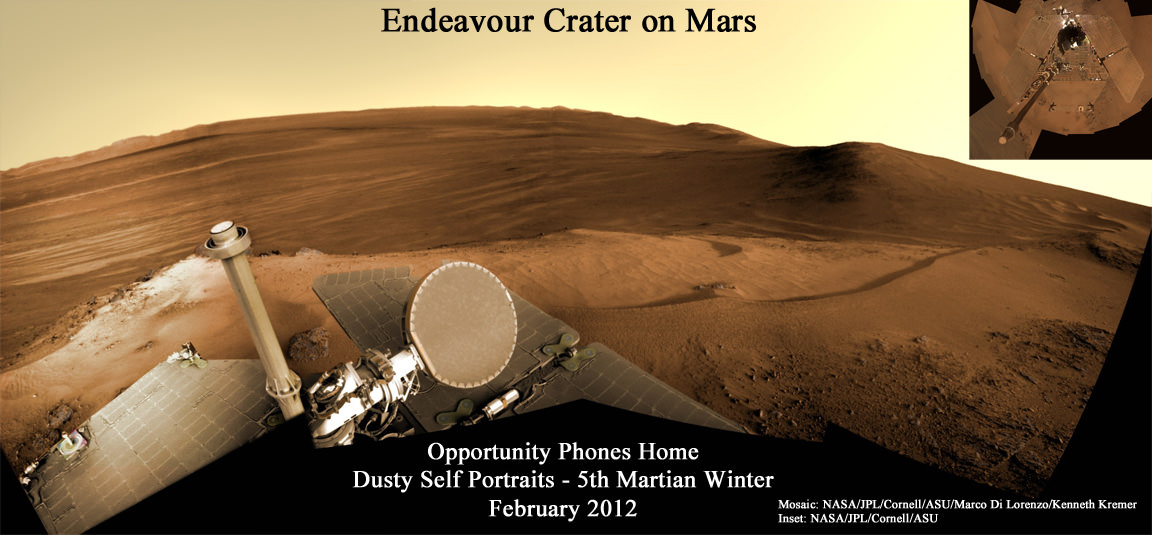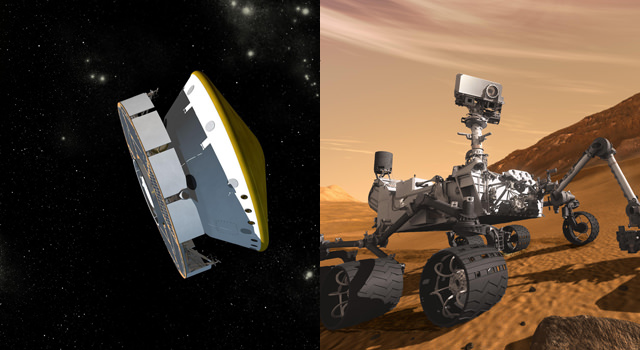En route to the Red Planet, Mars rover Curiosity has experienced the strongest solar radiation storm since 2005. No need to be alarmed: Researchers say it’s all part of Curiosity’s job as a ‘stunt double’ for human astronauts.
Opportunity Phones Home Dusty Self-Portraits and Ground Breaking Science
[/caption]
Opportunity, the Princess of Martian Robots, phoned home dusty new self portraits – above and below – of her beautiful bod basking in the utterly frigid sunshine during her 5th winter on the Red Planet whilst overlooking a humongous crater offering bountiful science.
NASA’s endearing robot is simultaneously carrying out an ambitious array of ground breaking science experiments this winter – providing insight into the mysterious nature of the Martian core – while sitting stationary until the energy augmenting rays of the springtime Sun shower down on Mars from the heavens above.
Opportunity’s current winter worksite is located at the rim of the vast crater named Endeavour, some 14 miles (22 kilometers) in diameter. The robot will remain parked for the winter on a slope at the north end of the crater rim segment called Cape York with an approximate 15-degree northerly tilt towards the life-giving sun to maximize solar energy production. The park-site is at an outcrop dubbed “Greeley Haven”, named in honor of Ronald Greeley, a beloved and recently deceased science team member.
The power killing dust buildup is readily apparent on the solar arrays and High Gain Antenna pictured in the new panoramic self-portraits of Opportunity’s wing-like deck. The red Martian dust also functions as a rather effective camouflage agent, sometimes blending the rover to near invisibility with the surface.
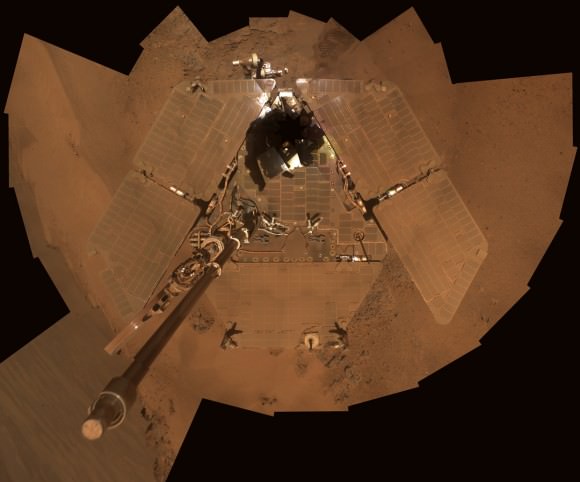
NASA's Mars Exploration Rover Opportunity shows dust accumulation on the rover's solar panels as the mission approached its fifth Martian winter at the rim of Endeavour Crater. Opportunity is located on the north-facing slope of a site called "Greeley Haven." This is a mosaic of images taken by Opportunity's panoramic camera (Pancam) during the 2,811th to 2,814th Martian days, or sols, of the rover's mission (Dec. 21 to Dec. 24, 2011). Credit: NASA/JPL-Caltech/Cornell/Arizona State Univ.
Indeed because Opportunity is covered with a thicker film of dust compared to her prior four Martian winters, the rover team was forced to employ the same “tilting” strategy they successfully used to keep her twin sister Spirit alive during her trio of Antarctic-like winters. This is the first winter that Opportunity did not have sufficient power to continue roving across the surface.
Since Opportunity is located just south of the Martian equator, the daylight hours for solar power generation are growing shorter until the southern Mars winter solstice occurs on March 30, 2012. As of mid- February 2012, the latest measure of solar array energy production was 274 watt-hours, compared to about 900 watt-hours at the start of the mission. See Solar Power energy graph below.
Power generation from the solar arrays has fluctuated up and down throughout Opportunity’s lifetime depending on when the completely unpredictable and fortuitous Martian wind storms chance by and miraculously clean the arrays of the rusty red dust.
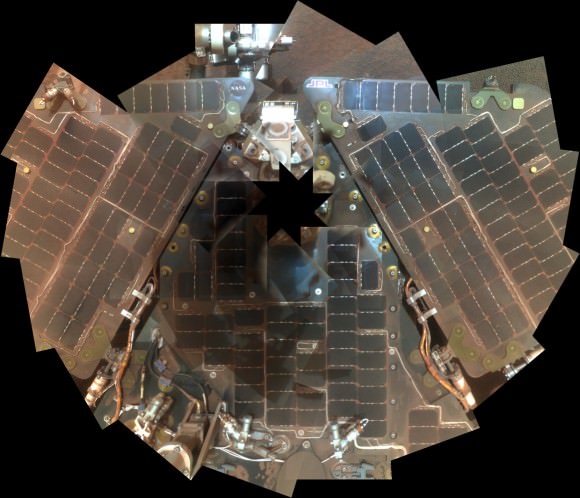
Opportunity used its panoramic camera (Pancam) during the mission's sols 1282 and 1284 (Sept. 2 and Sept. 4, 2007) to take the images combined into this mosaic view of the rover. The downward-looking view omits the mast on which the camera is mounted.The deck panorama is presented in approximate true color, the camera team's best estimate of what the scene would look like if humans were there and able to see it with their own eyes.Credit: NASA/JPL-Caltech/Cornell
The rover science team is ingeniously using the lack of movement to their advantage and Opportunity is still vigorously hard at work doing breakthrough research each and every day.
From her stationary position, Opportunity is conducting her first ever radio science Doppler tracking measurements to support geo-dynamic investigations and to elucidate the unknown structure of the Martian interior and core. The team was eager for the long awaited chance to carry out the radio tracking experiment with the High Gain Antenna (HGA) and determine if Mars core is liquid or solid. Months of data collection are required while the rover stays stationary.
“This winter science campaign will feature two way radio tracking with Earth to determine the Martian spin axis dynamics – thus the interior structure, a long-neglected aspect of Mars,” Ray Arvidson told Universe Today. Arvidson, of Washington University in St. Louis, is the deputy rover Principal Investigator.
Opportunity has nearly finished snapping the 13 filter, 360 degree stereo Greeley” panorama. The rover deployed the robotic arm onto the surface of the “Amboy” outcrop to collect multi-sol integrations with the Mössbauer Spectrometer and the largest ever mosaic campaign using the Microscopic Imager.
“We’ll do good science while we’re at Greeley Haven. But as soon as we catch a wind gust or the seasons change, we’ll be on our way again,” Steve Squyres told Universe Today. Squyres, of Cornell University is the rover Science Principal Investigator
“The Martian southern winter solstice occurs at the end of March. A few months after that date we will drive her off the outcrop and further explore Cape York,” Arvidson told me
The team will drive Opportunity in search of further evidence of the gypsum mineral veins like “Homestake” – indicative of ancient water flow – previously discovered at Cape York. Thereafter they’ll rove further south to investigate deposits of phyllosilicates, the clay minerals which stem from an earlier epoch when liquid water flowed on Mars eons ago and perhaps may have been more favorable to sustaining life.

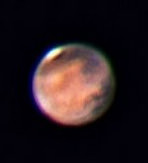
Opportunity is now well into her 9th year exploring hitherto unknown terrain on Mars, far exceeding anyone’s expectation. She landed inside a tiny crater on Jan. 24. 2004 for what was expected to be a mission of merely 90 Martian days, or Sols.
Today is Martian Sol 2873, that’s 32 times beyond the rover designers “warranty” for NASA’s Opportunity rover.
Altogether, Opportunity has journeyed more than 21 miles (34 kilometers) across the Red Planet’s surface, marking the first overland expedition on another Planet. See our route map below.
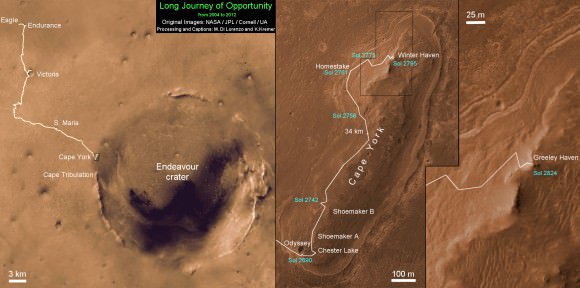
Traverse map shows the 8 Year Journey of Opportunity from Eagle Crater landing site on Sol 1- Jan. 24, 2004 - to 5th Winter Haven worksite at Greeley Haven at Endeavour Crater rim in January 2012. Opportunity embarked on a crater tour and discovered bountiful evidence for the flow of liquid water on Mars billions of years ago. Endeavour Crater is 14 miles 22 kilometers) in diameter. Opportunity has driven more than 21 miles (34 km). Credit: NASA/JPL/Cornell/UA/Marco Di Lorenzo/Kenneth Kremer
Meanwhile, NASA’s Curiosity Mars Science Laboratory rover is rocketing through space and on course for a pinpoint touchdown inside the layered terrain of Gale Crater on August 6, 2012. Curiosity is now America’s last planned Mars rover following the cancellation of the joint NASA/ESA ExoMars rover mission in the Obama Administrations newly announced Fiscal 2013 NASA budget.
Experts React to Obama Slash to NASA’s Mars and Planetary Science Exploration

[/caption]
Earth’s next Mars Rover – NOT Made in USA
Just days after President Obama met with brilliant High School students at the 2012 White House Science Fair to celebrate their winning achievements and encourage America’s Youth to study science and take up careers in the Science, Technology, Engineering and Math (STEM) technical fields, the Obama Administration has decided on deep budgets cuts slashing away the very NASA science programs that would inspire those same students to shoot for the Stars and Beyond and answer the question – Are We Alone ?
Last year, the Obama Administration killed Project Constellation, NASA’s Human Spaceflight program to return American astronauts to the Moon. This year, the President has killed NASA’s ExoMars Robotic Spaceflight program aimed at dispatching two ambitious missions to Mars in 2016 and 2018 to search for signs of life.
Both ExoMars probes involved a joint new collaboration with the European Space Agency (ESA) carefully crafted to share costs in hard times and get the most bang for the buck – outlined in my earlier Universe Today story, here.
Expert Scientists and Policy makers have been voicing their opinions.
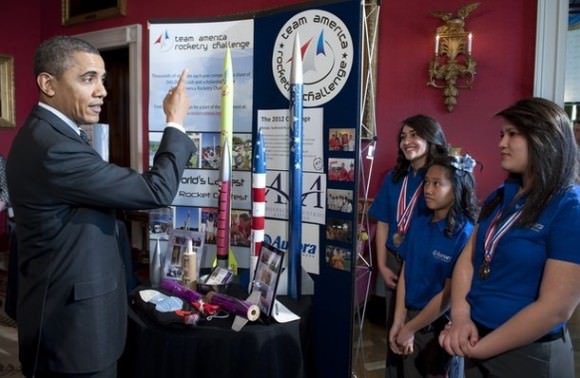
President Barack Obama hosted the winning science fair students from a range of nationwide competitions at the 2nd White House Science Fair on February 7, 2012. The ExoMars missions were eliminated from the NASA budget announced on Feb. 13, 2012.
All of NASA’s “Flagship” Planetary Science missions have now been cancelled in the 2013 Fiscal Year Budget proposed on Feb. 13, and others missions have also been curtailed due to the severe economy.
“There is no room in the current budget proposal from the President for new Flagship missions anywhere,” said John Grunsfeld, NASA’s Associate Administrator for Science at a NASA budget briefing for the media on Feb. 13.
ESA is now looking to partner with Russia as all American participation in ExoMars is erased due to NASA’ s forced pull out.
On Feb. 13, NASA’s Fiscal 2013 Budget was announced and the Obama Administration carved away nearly half the Mars mission budget. Altogether, funding for NASA’s Mars and Planetary missions in the Fiscal 2013 budget would be sliced by $300 million – from $1.5 Billion this year to $1.2 Billion in 2013. NASA was forced to gut the Mars program to pay for the cost overruns of the James Webb Space Telescope.
Mars rover scientist Prof. Jim Bell of Arizona State University and President of The Planetary Society (TPS) told Universe Today that “no one expects increases”, but cuts of this magnitude are “cause for concern”.
NASA’s robotic missions to Mars and other solar system bodies have been highly successful, resulted in fundamental scientific breakthroughs and are wildly popular with students and the general public.
“With these large proposed cuts to the NASA Mars exploration program, there will be a lot of cause for concern,” said Bell.
“The Mars program has been one of NASA’s crown jewels over the past 15 years, both in terms of science return on investment, and in terms of public excitement and engagement in NASA’s mission. It would also represent an unfortunate retreat from the kind of international collaboration in space exploration that organizations like The Planetary Society so strongly support.”
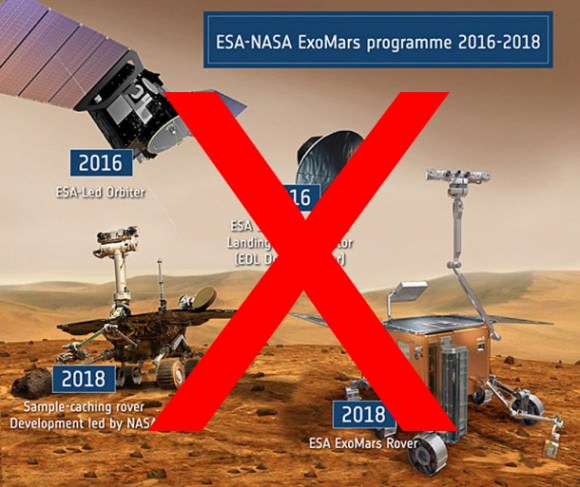
Bell and other scientists feel that any cuts should be balanced among NASA programs, not aimed only at one specific area.
“Certainly no one expects increasing budgets in these austere times, and it is not useful or appropriate to get into a battle of “my science is better than your science” among the different NASA Divisions and Programs.” Bell told me.
“However, it would be unfortunate if the burden of funding cuts were to befall one of NASA’s most successful and popular programs in a disproportionate way compared to other programs. As Ben Franklin said, “We should all hang together, or surely we will all hang separately.”
Bell added that science minded organizations should work with Congress to influence the debate over the coming months.
“Of course, this would only be an initial proposal for the FY13 and beyond budget. Over the winter, spring, and summer many professional and public organizations, like TPS, will be working with Congress to advocate a balanced program of solar system exploration that focuses on the most important science goals as identified in the recent NRC Planetary Decadal Survey, as well as the most exciting and publicly compelling missions that are supported by the public–who ultimately are the ones paying for these missions.”
“Let’s hope that we can all find a productive and pragmatic way to continue to explore Mars, the outer solar system, and our Universe beyond,” Bell concluded.
“The impact of the cuts … will be to immediately terminate the Mars deal with the Europeans,” said Scott Hubbard, of Stanford University and a former NASA planetary scientist who revived the agency’s Mars exploration program after failures in 1999, to the Washington Post. “It’s a scientific tragedy and a national embarrassment.”
“I encourage whoever made this decision to ask around; everyone on Earth wants to know if there is life on other worlds,” Bill Nye, CEO of The Planetary Society, said in a statement. “When you cut NASA’s budget in this way, you’re losing sight of why we explore space in the first place.”
“There is no other country or agency that can do what NASA does—fly extraordinary flagship missions in deep space and land spacecraft on Mars.” Bill Nye said. “If this budget is allowed to stand, the United States will walk away from decades of greatness in space science and exploration. But it will lose more than that. The U.S. will lose expertise, capability, and talent. The nation will lose the ability to compete in one of the few areas in which it is still the undisputed number one.”
Ed Weiler is NASA’s recently retired science mission chief (now replaced by Grunsfeld) and negotiated the ExoMars program with ESA. Weiler actually quit NASA specifically in opposition to the Mars Program cuts ordered by the Office of Management and Budget (OMB) and had these comments for CBS News;
“To me, it’s bizarro world,” Weiler said an interview with CBS News. “Why would you do this? The President of the United States, President Obama, declared Mars to be the ultimate destination for human exploration. Obviously, before you send humans to the vicinity of Mars or even to land on Mars, you want to know as much about the planet as you possibly can. … You need a sample return mission. The president also established a space policy a few years ago which had the concept of encouraging all agencies to have more and more foreign collaboration, to share the costs and get more for the same bucks.”
“Two years ago, because of budget cuts in the Mars program, I had to appeal to Europe to merge our programs. … That process took two long years of very delicate negotiations. We thought we were following the president’s space policy exactly. Congressional reaction was very positive about our activities. You put those factors in place and you have to ask, why single out Mars? I don’t have an answer.”
Space Analysts and Political leaders also weighed in:
“The president’s budget is just a proposal,” said Howard McCurdy, a space-policy specialist at American University in Washington to the Christian Science Monitor.
The cuts “reflect the new reality” in which the economy, budget deficits, and the federal debt have elbowed their way to the top of Washington’s agenda, McCurdy adds.
“You don’t cut spending for critical scientific research endeavors that have immeasurable benefit to the nation and inspire the human spirit of exploration we all have,” said Rep. John Culberson (R-Tex.). Texas is home to NASA’s Johnson Space Center.
Rep. Adam Schiff (D-CA), who represents the district that’s home to the Jet Propulsion Laboratory (JPL), released this statement following his meeting with NASA Administrator Charles Bolden to discuss the agency’s 2013 budget proposal:
“Today I met with NASA Administrator Charles Bolden to express my dismay over widespread reports that NASA’s latest budget proposes to dramatically reduce the planetary science program, and with it, ground breaking missions to Mars and outer planetary bodies like Jupiter’s icy moon Europa, and to inform him of my vehement opposition to such a move.”
“America’s unique expertise in designing and flying deep-space missions is a priceless national asset and the Mars program, one of our nation’s scientific crown jewels, has been a spectacular success that has pushed the boundaries of human understanding and technological innovation, while also boosting American prestige worldwide and driving our children to pursue science and engineering degrees in college.
“As I told the Administrator during our meeting, I oppose these ill-considered cuts and I will do everything in my power to restore the Mars budget and to ensure American leadership in space exploration.”
In an interview with the San Gabriel Valley Tribune, Schiff said, “What they’re proposing will be absolutely devastating to planetary science and the Mars program. I’m going to be fighting them tooth and nail. Unfortunately if this is the direction the administration is heading, it will definitely hurt JPL – that’s why I’m so committed to reversing this.”
NASA still hopes for some type of scaled back Mars missions in the 2016 to 2020 timeframe which will be outlined in an upcoming article.
In the meantime, the entire future of America’s Search for Life on the Red Planet now hinges on NASA’s Curiosity Mars Science Laboratory rover speeding thru interplanetary space and a pinpoint touchdown inside the layered terrain of Gale Crater on August 6, 2012.
Curiosity will be NASA’s third and last generation of US Mars rovers – 4th Generation Axed !
NASA’s Opportunity Rover is now Earth’s only surviving robot on Mars
Budget Axe to Gore America’s Future Exploration of Mars and Search for Martian Life

[/caption]
America’s hugely successful Mars Exploration program is apparently about to be gutted by Obama Administration officials wielding a hefty budget axe in Washington, D.C. Consequently, Russia has been invited to join the program to replace American science instruments and rockets being scrapped.
NASA’s Fiscal 2013 Budget is due to be announced on Monday, February 13 and its widely reported that the Mars science mission budget will be cut nearly in half as part of a significant decline in funding for NASA’s Planetary Science Division.
The proposed deep slash to the Mars exploration budget would kill NASA’s participation in two new missions dubbed “ExoMars” set to launch in 2016 and 2018 as a joint collaboration with the European Space Agency (ESA).
The ESA/NASA partnership would have dispatched the Trace Gas Orbiter to the Red Planet in 2016 to search for atmospheric methane, a potential signature for microbial life, and an advanced Astrobiology rover to drill deeper into the surface in 2018. These ambitious missions had the best chance yet to determine if Life ever evolved on Mars.
The 2016 and 2018 ExoMars probes were designed to look for evidence of life on Mars and set the stage for follow on missions to retrieve the first ever soil samples from the Red Planet’s surface and eventually land humans on Mars.

- Planned 2016 Orbiter and 2018 Rover. NASA participation will be scrapped due to slashed NASA funding by the Obama Admnistartion. Credit: ESA
The proposed Mars budget cuts will obliterate these top priority science goals for NASA.
The BBC reports that “ a public announcement by NASA of its withdrawal from the ExoMars program will probably come once President Obama’s 2013 Federal Budget Request is submitted.”
A Feb. 9 article in ScienceInsider, a publication of the journal Science, states that “President Barack Obama will propose a $300 million cut in NASA’s planetary science programs as part of his 2013 request for the agency.”
This would amount to a 20% cut from $1.5 Billion in 2012 to $1.2 Billion in 2013. The bulk of that reduction is aimed squarely at purposefully eliminating the ExoMars program. And further deep cuts are planned in coming years !
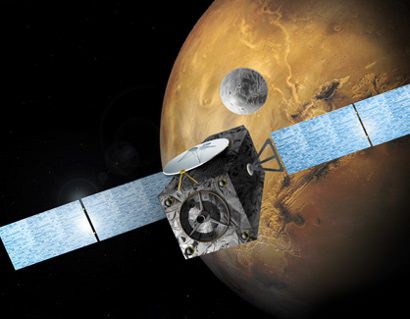
The Mars budget of about $580 million this year would be radically reduced by over $200 million, thereby necessitating the end of NASA’s participation in ExoMars. These cuts will have a devastating impact on American scientists and engineers working on Mars missions.
The fallout from the looming science funding cuts also caused one longtime and top NASA manager to resign.
According to ScienceInsider, Ed Weiler, NASA’s science mission chief, says he “quit NASA Over Cuts to Mars Program.”
“The Mars program is one of the crown jewels of NASA,” said Ed Weiler to ScienceInsider.
“In what irrational, Homer Simpson world would we single it out for disproportionate cuts?”
“This is not about the science mission directorate, this is not even about NASA. This is about the country. We are the only country in the world that has demonstrated the capability to land anything on Mars. How can we allow that to be undermined?”
Weiler’s resignation from NASA on Sept. 30, 2011 was sudden and quick, virtually from one day to the next. And it came shortly after the successful launch of NASA’s GRAIL lunar probes, when I spoke to Weiler about Mars and NASA’s Planetary Science missions and the gloomy future outlook. Read my earlier Universe Today story about Weiler’s retirement.
Ed Weiler was the Associate Administrator for NASA’s Science Mission Directorate (SMD) and his distinguished career spanned almost 33 years.
The dire wrangling over NASA’s 2013 budget has been ongoing for many months and some of the funding reductions had already leaked out. For example NASA had already notified ESA that the US could not provide funding for the Atlas V launchers in 2016 and 2018. Furthermore, Weiler and other NASA managers told me the 2018 mission was de-scoped from two surface rovers down to just one to try and save the Mars mission program.
ESA is now inviting Russian participation to replace the total American pullout, which will devastate the future of Red Planet science in the US. American scientists and science instruments would be deleted from the 2016 and 2018 ExoMars missions.
The only approved US mission to Mars is the MAVEN orbiter due to blastoff in 2013 – and there are NO cameras aboard MAVEN.
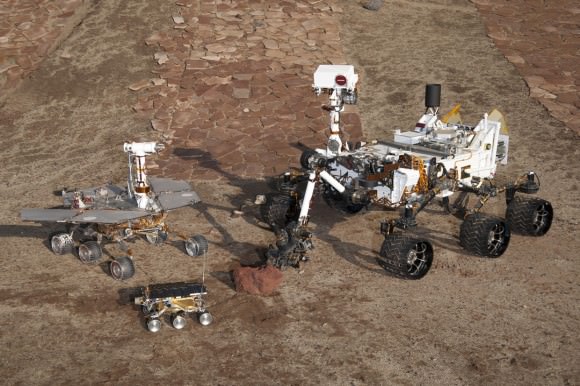
NASA is caught in an inescapable squeeze between rising costs for ongoing and ambitious new missions and an extremely tough Federal budget environment with politicians of both political affiliations looking to cut what they can to rein in the deficit, no matter the consequences of “killing the goose that laid the golden egg”.
NASA Watch Editor Keith Cowing wrote; “Details of the FY 2013 NASA budget are starting to trickle out. One of the most prominent changes will be the substantial cut to planetary science at SMD [NASA’s Science Mission Directorate]. At the same time, the agency has to eat $1 billion in Webb telescope overruns – half of which will come out of SMD.”
The cost of the James Webb Space Telescope (JWST) has skyrocketed to $8.7 Billion.
To pay for JWST, NASA is being forced to gut the Mars program and other science missions funded by the same Science Mission Directorate that in the past and present has stirred the public with a mindboggling payoff of astounding science results from many missions that completely reshaped our concept of humankinds place in the Universe.
Meanwhile, China’s space program is rapidly expanding and employing more and more people. China’s scientific and technological prowess and patent applications are increasing and contributing to their fast growing economy as American breakthroughs and capabilities are diminishing.
Under the budget cutting scenario of no vision, the Curiosity Mars Science Laboratory rover will be America’s last Mars rover for a long, long time. Curiosity will thus be the third and last generation of US Mars rovers – 4th generation to be Axed !
Spirit Lander – 1st Color Image from Mars Orbit

[/caption]
The Lander platform for NASA’s Spirit rover has been photographed in stunning high resolution color for the first time from Mars orbit – just over 8 years after the now legendary robot survived the scorching atmospheric heat of the 6 minute plunge through the Martian atmosphere and bounced to a stop inside Gusev Crater on January 3, 2004.
Spirit’s three petaled landing pad was finally imaged in color by NASA’s powerful Mars Reconnaissance Orbiter (MRO) spacecraft just days ago on January 29, 2012 at 3:04 p.m. local Mars time.
The MRO spacecraft was soaring overhead and captured the image of Spirit’s lander with the high resolution HiRISE camera from a distance of some 262 kilometers, (162 miles).
“HiRISE has never before imaged the actual lander for the Spirit rover in color, [located] on the west side of Bonneville Crater,” writes Alfred McEwen, HiRISE Principal Investigator at the University of Arizona.

Spirit landing pad at lower left; Bonneville Crater rim at top right.
Credit: NASA/JPL/UA/HiRISE
While protectively cocooned inside the airbag cushioned lander, Spirit bounced about two dozen times before rolling to rest on the Martian plains about ¼ mile away from Bonneville Crater. Then her landing petals unfurled, the airbags were partially retracted and Spirit eventually drove off the landing pad.
“The lander is still bright, but with a reddish color, probably due to a [Martian] dust cover.”
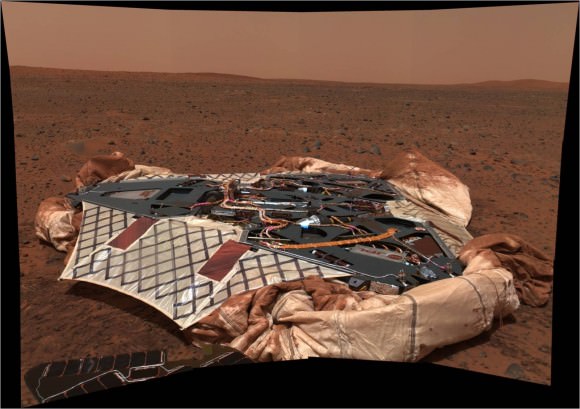
- Now imaged for the 1st time from Mars orbit by NASA’s MRO spacecraft. Lander had 3-petals and airbags. Credit: NASA/JPL-Caltech/Cornell
Spirit initially drove to Bonneville Crater and circumnavigated part way around the rim before speeding off towards the Columbia Hills, about 2 miles to the East. She eventually scaled the summit of Husband Hill and drove down the opposite side to the Home Plate” volcanic feature where she rests today – see travse map below.
“A bright spot from a remnant of the heat shield is still visible on the north rim of Bonneville Crater. The backshell and parachute are still bright, but were not captured in the narrow color swath.”
“The rover itself can still be seen near “Home Plate” in the Columbia Hills, but there is no obvious sign of rover tracks–erased by the wind,” McEwen notes.
Here is a photo taken by Spirit looking back to the lander – now imaged in color from orbit for the first time – for a comparative view, before she drove off forever.
Spirit endured for more than six years of bonus time exploration beyond her planned 90 day mission. And Opportunity is still roving Mars today !

Curiosity – NASA’s newest, biggest ever and maybe last Mars rover – is speeding through interplanetary space for an August 2012 landing inside Gale Crater.
Read my 8th Year Anniversary articles about Spirit and Opportunity on Mars – here and here
NASA’s Resilient Rover Opportunity Begins Year 9 On Mars with Audacious Science Ahead
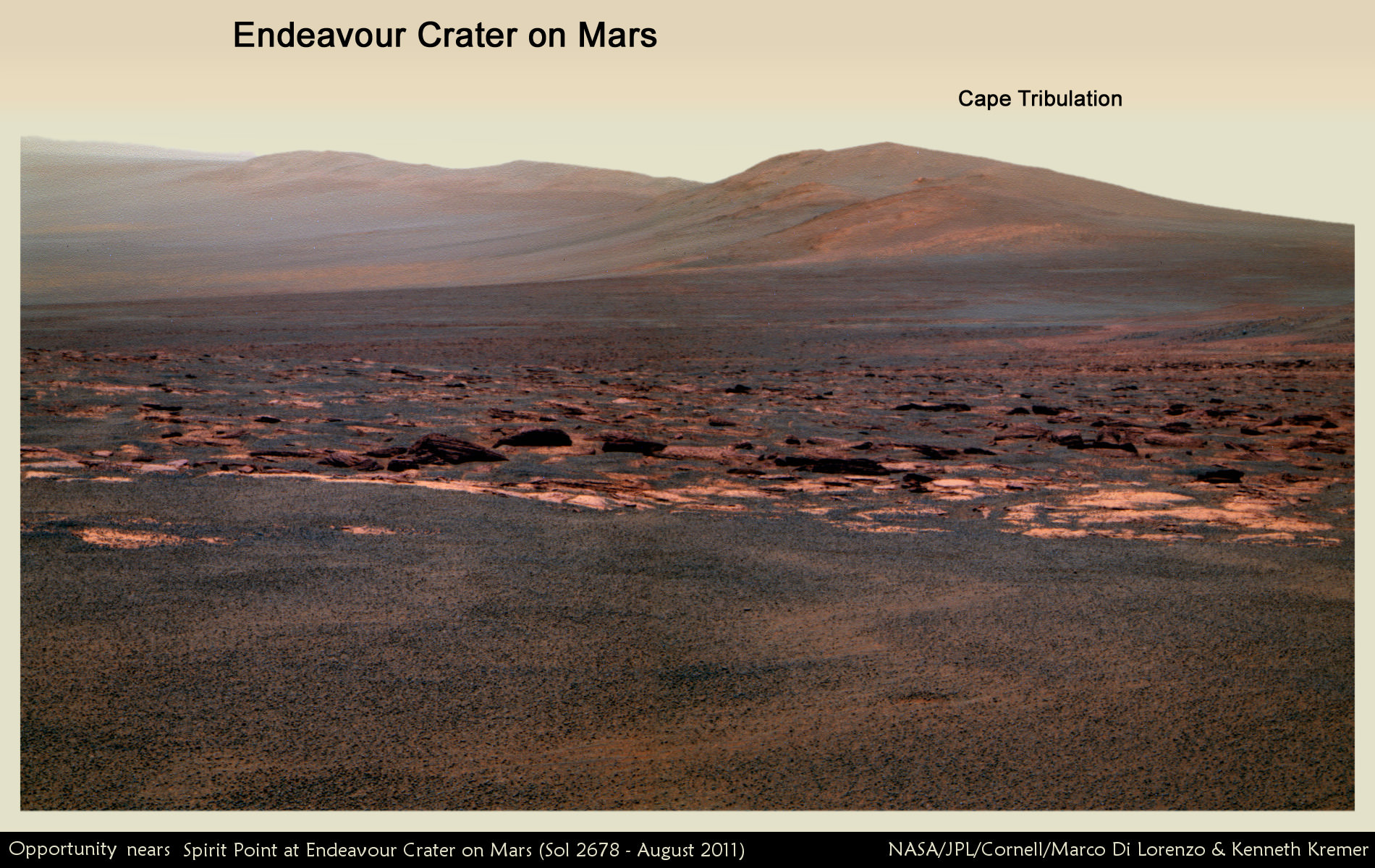
[/caption]
Today, the resilient Opportunity robot begins her 9th year roving around beautifully Earth-like Martian terrain where potentially life sustaining liquid water once flowed billions of years ago.
Opportunity celebrates her 8th anniversary on the Red Planet gazing at the foothills of the vast crater named Endeavour, promising a “mother lode” of “watery” science – an unimaginable circumstance since the nail biting landing on the hematite rich plains of Meridiani Planum on 24 January 2004.
“Opportunity is 97 months into the 3 month mission,” team members are proud and universally surprised to say.
“Milestones like 8 years on Mars always make me look forward rather than looking back,” Rover Principal Investigator Prof. Steve Squyres of Cornell University told Universe Today for this article commemorating Opportunity’s landing.
“We’ve still got a lot of exploring to do, but we’re doing it with a vehicle that was designed for a 90-sol mission. That means that every sol is a gift at this point.”
Opportunity has driven more than 21 miles (34 kilometers) across the Red Planet’s surface during what is truly humankind’s first overland expedition on another Planet. See our route map below.

Traverse map shows the 8 Year Journey of Opportunity from Eagle Crater landing site on Sol 1- Jan. 24, 2004 - to 5th Winter Haven worksite at Greeley Haven at Endeavour Crater rim in January 2012. Opportunity embarked on a crater tour and discovered bountiful evidence for the flow of liquid water on Mars billions of years ago. The robot has shown that ancient ephemeral shallow lakes existed on Mars when the cratered terrain was cut by fluvial channels. Endeavour Crater is 14 miles (22 kilometers) in diameter. Opportunity has so far driven more than 21 miles (34 km) over 8 Years but was only expected to live for 90 Martian days. Credit: NASA/JPL/Cornell/UA/Marco Di Lorenzo/Kenneth Kremer
NASA’s twin rovers Spirit and Opportunity blasted off for Mars atop a pair of Delta II rockets in the summer of 2003 with a mission “warranty” of just 90 Martian days, or Sols.
Today is Sol 2846 of working operations for Opportunity, compared to an anticipated lifetime of only 90 Sols – that amounts to more than 31 times beyond the designer’s expectations.
Indeed, the long lived robot is now enduring her 5th Winter on Mars. And to glimpse the next Martian sunrise, the robo girls manmade components must survive the harsh extremes of frigid Antarctic-like temperatures each and every sol.
“I never thought that we would still be planning sequences for Opportunity today,” Ray Arvidson told Universe Today. Arvidson, of Washington University in St. Louis, is the deputy rover principal investigator.
“I seriously thought both Spirit and Opportunity would be finished by the summer of 2004.”
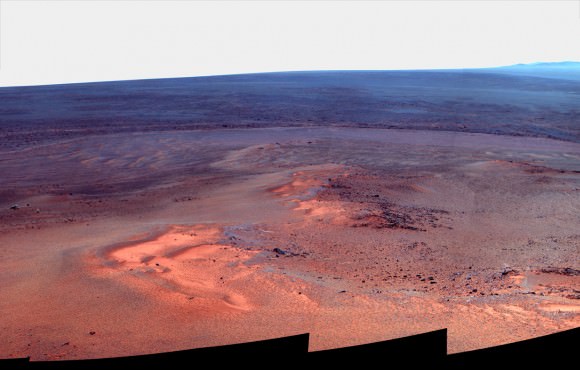
But, Opportunity is the gift to science that keeps on giving.
“I am feeling pretty good as the MER rover anniversaries approach,” Arvidson told me.
“Opportunity has shown that ancient ephemeral shallow lakes existed as Mars moved climatically from an early period when the cratered terrain was cut by fluvial channels to the current dry and cold conditions that dominate.”
“Both rovers have conclusively shown the need for lateral mobility to get to relevant outcrops and back out the secrets associated with past conditions,” Arvidson explained.
Barely a month ago the bountiful harvest from mobility was once again demonstrated when the science team lead by Squyres and Arvidson announced that Opportunity had discovered the most scientifically compelling evidence yet for the flow of liquid water on ancient Mars.
Squyres and Arvidson announced that Opportunity had found a bright vein – named “Homestake” – composed of the mineral gypsum located at the Cape York segment of Endeavour Crater where the intrepid robot is currently spending her 5th Martian Winter.
“This gypsum vein is the single most powerful piece of evidence for liquid water at Mars that has been discovered by the Opportunity rover,” Squyres explained.
Veins are a geologic indication of the past flow of liquid water.
See our mosaic below illustrating the exact location of the “Homestake” vein at Endeavour Crater – also published at Astronomy Picture of the Day; 12 Dec 2011.
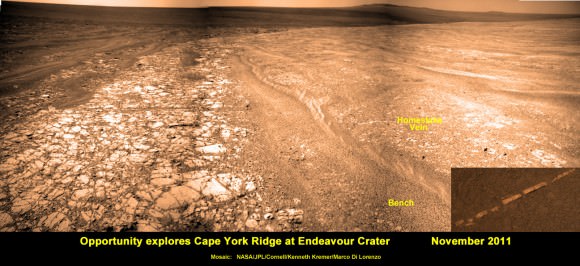
Opportunity rover discovered Gypsum at the Homestake mineral vein, while exploring around the base of Cape York ridge at the rim of Endeavour Crater. The vein is composed of calcium sulfate and indicates the ancient flow of liquid water at this spot on Mars. This panoramic mosaic of images was taken on Sol 2761, November 2011, and illustrates the exact spot of the mineral vein discovery.
Credit: NASA/JPL/Cornell/Kenneth Kremer/Marco Di Lorenzo
Published on Astronomy Picture of the Day (APOD): 12 Dec 2011
Opportunity just arrived at the rim of the 14 mile (22 kilometer) wide Endeavour Crater in mid-August 2011 following an epic three year trek across treacherous dune fields from her prior investigative target at the ½ mile wide Victoria Crater.
“It’s like a whole new mission since we arrived at Cape York,” says Squyres.
For the next few months of the bitterly cold Martian winter, Opportunity will conduct a vigorous science campaign while remaining mostly stationary at a spot dubbed “Greeley Haven” in honor of Prof. Ronald Greeley, a team member from Arizona State University who recently passed away.

This mosaic shows the view of NASA’s Opportunity rover parked at “Greeley Haven” worksite where the robot will spend her 5th Martian Winter. This mosaic of images shows the Winter Haven view from the Cape York Ridge at the western rim of Endeavour Crater looking south along the crater rim. Tire tracks at right. Credit: NASA/JPL/Cornell/ Marco Di Lorenzo/Kenneth Kremer
At this moment Opportunity is snapping a 360 degree panorama, deploying her robotic arm onto nearby outcrops, collecting microscopic images, making measurements of mineral compositions with the Alpha Particle X-Ray Spectrometer and conducting radio science observations to elucidate the unknown structure of the Martian interior and core.
The rover is covered with a significant coating of dust which limits her ability to generate power from the life sustaining solar arrays. Since Opportunity is traversing just south of the equator, engineers have temporarily parked her on a northerly facing slope to maximize the electric power generation.
“Opportunity is currently sitting on an outcrop of impact breccias at Greeley Haven on Cape York,” said Arvidson.
Opportunity will remain at Greeley Haven until some time after the Winter Solstice of southern Martian winter occurs at the end of March.

Then she’ll head south to further explore the veins and eventually drive to deposits of the clay mineral located a few miles (km) away along the craters rim.
“We’ll do good science while we’re at Greeley Haven. But as soon as we catch a wind gust or the seasons change, we’ll be on our way again,” Squyres told me.
The legendary twins Spirit and Opportunity surely rank as one of the greatest triumphs in space exploration.
Opportunity arrives at Greeley Haven – 5th Winter Haven Worksite on Mars
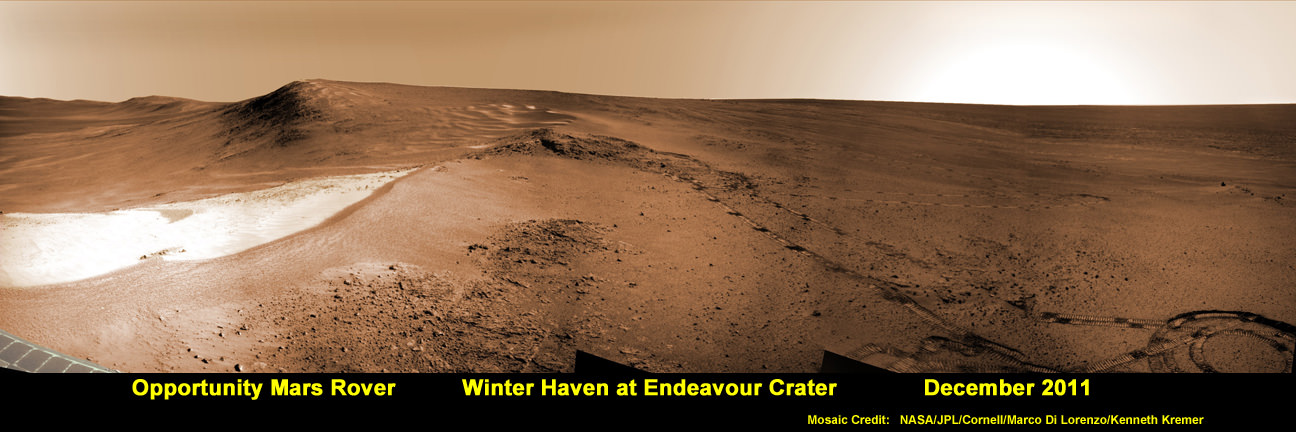
[/caption]
NASA’s seemingly indestructible Opportunity rover has arrived at the breathtaking location where she’ll be working through her unfathomable 5th Martian Winter. The Opportunity Mars Exploration Rover has not only endured, but flourished for 8 years of unending “Exploration & Discovery” on the Red Planet despite having an expected lifetime at landing of just 3 months, way back in January 2004.
Opportunity is parked at a northward facing outcrop dubbed “Greeley Haven” where she can soak up the sun and juice her innards throughout the utterly harsh and Antarctic-like temperatures on tap for the next few months that threaten to kill her each and every Martian day. See our mosaic above around the Greeley Haven area.
Science team members told Universe Today that the rover is sitting at Greeley Haven because the site offers a roughly 15 degree tilt that will maximize the electric output from the life-giving solar arrays and also allow the robot to carry out a vigorous science campaign during the seasonal Martian winter season that officially begins in March.
Greeley Haven is a located at the northern tip of the “Cape York” segment of the western rim of the vast crater named Endeavour, some 14 miles (22 km) wide that’s loaded with a bountiful variety of rocks and soil that neither Opportunity nor her twin Spirit have ever touched and drilled into before and stem from an earlier epoch when liquid water flowed eons ago and perhaps may have been more favorable to sustaining life.
“Opportunity is currently sitting on Saddleback at Greeley Haven, an outcrop of impact breccias on Cape York, Endeavour crater’s rim,” Ray Arvidson told Universe Today. Arvisdon is the mission’s deputy principal investigator, of Washington University in St. Louis.
“Her northerly tilt is about ~15 degrees which is enough to have a vibrant winter campaign. The Martian southern winter solstice occurs at the end of March. A few months after that date we will drive her off the outcrop and further explore Cape York.”
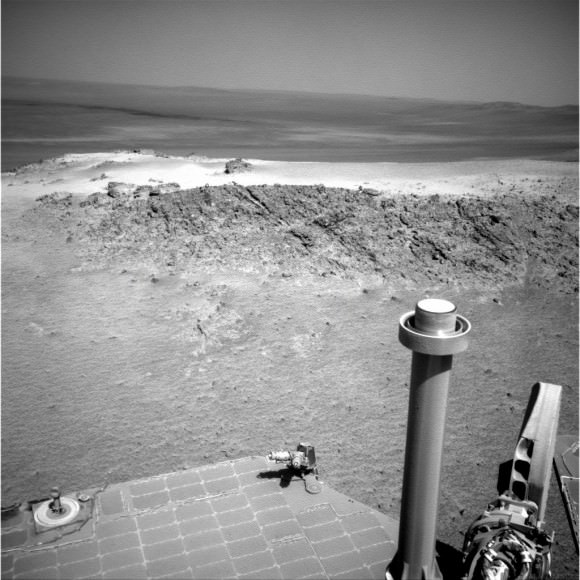
Opportunity captured this view of a northward-facing outcrop, "Greeley Haven," where the rover will work during its fifth Martian winter. This southward-looking image was taken on Sol 2790 on Mars (Nov. 29, 2011). The rover team chose this designation as a tribute to the influential planetary geologist Ronald Greeley (1939-2011), who was a member of the science team for the Mars rovers and many other interplanetary missions. Credit: NASA/JPL-Caltech
“Greeley Haven” is named in tribute to planetary Geologist Ronald Greeley (1939-2011) who was a beloved member of the rover science team and a host of other NASA planetary missions. He taught at Arizona State University and inspired several generations of students and planetary scientists until his recent death on Oct. 27, 2011.
“We’ll hunker down at Greeley Haven as long as we need to, and we’ll do good science while we’re there,” Steve Squyres of Cornell University, Ithaca, N.Y., told Universe Today. Squyres is the Principal Investigator for Opportunity.
Opportunity is collecting a high resolution 360 degree panorama to commemorate Greeley.
Throughout the past 4 Martian winters, Opportunity had continued to traverse without pause. But this winter time it’s different because the solar panels are significantly more coated with an obscuring layer of dust hindering their energy output.
So the rover is parked with a tilt for her 5th Martian winter, mimicking the successful strategy power boosting used by Spirit to survive 3 harsh Martian winters.
And there is a silver lining to sitting mostly still that enables a chance to determine what’s at the core of the Red Planet, a key fact we don’t know.
“This winter science campaign will feature two way radio tracking with Earth to determine the Martian spin axis dynamics – thus the interior structure, a long-neglected aspect of Mars,” Arvidson told me.
I asked Squyres for a progress update and how long would the data collection require ?
Squyres replied that the experiment has already begun and added – “Hard to say how long. It’s months, as opposed to weeks or years, but it depends very much on data quality and the amount of data we get per week. We’re very early in the experiment now… we’ll just see how it goes.”
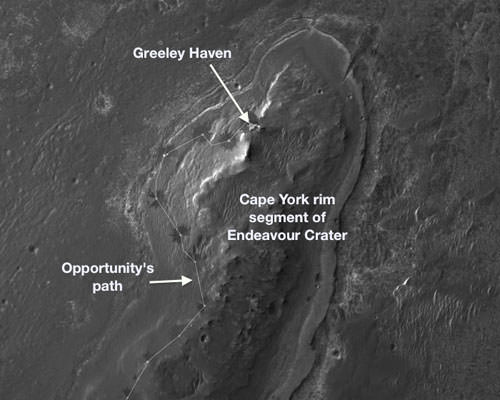
Opportunity will spend its fifth Martian winter working at Greeley Haven on the western rim of Endeavour Crater. Credit: NASA/JPL-Caltech/UA
3 Generations of NASA’s Mars Rovers

[/caption]
NASA Mars rovers have come a long way in terms of size and capability since the rebirth of Red Planet surface exploration just 15 years ago – spanning from 1997 to 2012.
To get a really excellent sense of just how far America’s scientists and engineers have pushed the state of the art in such a short time – when the willpower and funding existed and coincided to explore another world – take a good look at the new pictures here showing 3 generations of NASA’s Mars rovers; namely Mars Pathfinder (MPF), the 1st generation Mars rover, Mars Exploration Rover (MER), the 2nd generation, and Mars Science Laboratory (MSL), the 3rd and newest generation Mars rover.
The newly released pictures graphically display a side by side comparison of the flight spare for Mars Pathfinder (1997 landing) and full scale test rovers of the Mars Exploration Rover (2004 landing) and Mars Science Laboratory (in transit for a 2012 planned landing). The setting is inside the “Mars Yard” at NASA’s Jet Propulsion Laboratory, Pasadena, Calif. where the teams conduct mission simulations.
It’s been nothing less than a quantum leap in advancement of the scientific and technological capability from one generation to the next.
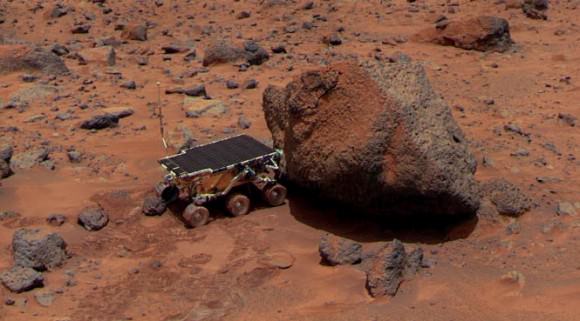
Sojourner takes an Alpha Proton X-ray Spectrometer (APXS) measurement of Yogi rock after Red Planet landing on July 4, 1997 landing. Sojourner was only 2 feet long, the size of a microwave oven.
Credit: NASA
Just consider the big increase in size – growing from a microwave oven to a car !
The “Marie Curie” flight spare and the actual “Sojourner” rover on Mars are 2 feet (65 centimeters) long – about the size of a microwave oven. The MER rovers “Spirit and Opportunity” and the “Surface System Test Bed” rover are 5.2 feet (1.6 meters) long – about the size of a golf cart. The MSL “Curiosity” and the “Vehicle System Test Bed” rover are 10 feet (3 meters) long – about the size of a car.
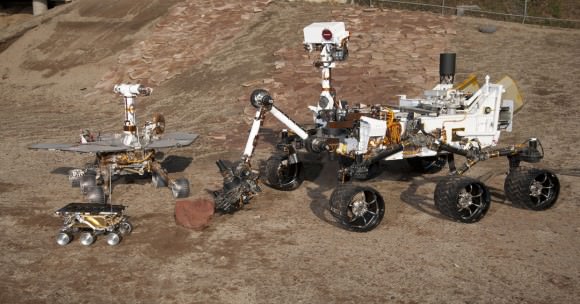
Front; flight spare for the first Mars rover, Sojourner. Left; Mars Exploration Rover Project test rover. Right; Mars Science Laboratory test rover Credit: NASA/JPL-Caltech
With your own eyes you can see the rapid and huge generational change in Mars rovers if you have the opportunity to visit the Kennedy Space Center Visitor Complex and stroll by the Mars exhibit with full scale models of all three of NASA’s Red Planet rovers.
At the KSC Visitor Complex in Florida you can get within touching distance of the Martian Family of Rovers and the generational differences in size and complexity becomes personally obvious and impressive.
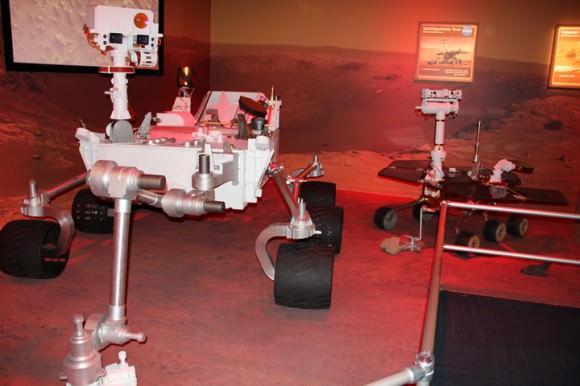
Full scale models on display at the Kennedy Space Center Visitor Complex. Curiosity and Spirit/Opportunity are pictured here. Sojourner out of view. Credit: Ken Kremer
All of the Mars rovers blasted off from launch pads on Cape Canaveral Air Force Station, Florida.
Sojourner, Spirit and Opportunity launched atop Delta II rockets at Space Launch Complex 17 in 1996 and 2003. Curiosity launched atop an Atlas V at Space Launch Complex 41 in 2011.
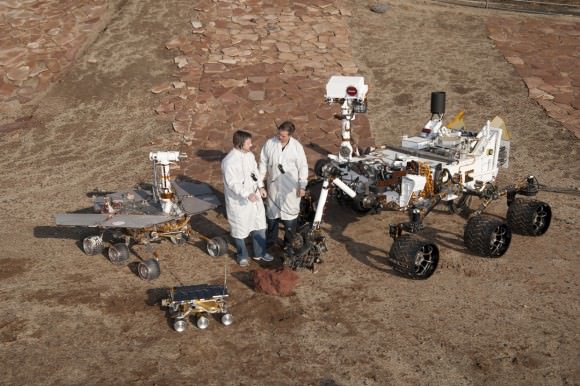
The rovers are pictured here with real Mars Engineers to get a sense of size and perspective. Front rover is the flight spare for the first Mars rover, Sojourner. At left is a Mars Exploration Rover Project test rover, working sibling to Spirit and Opportunity. At right is a Mars Science Laboratory test rover the size of Curiosity which is targeting a August 2012 Mars landing. The Mars engineers are JPL's Matt Robinson, left, and Wesley Kuykendall. Credit: NASA/JPL-Caltech
Opportunity is still exploring Mars to this day – 8 years after landing on the Red Planet, with a warranty of merely 90 Martian days.
Curiosity is scheduled to touch down inside Gale crater on 6 August 2012.
So, what comes next ? Will there be a 4th Generation Mars rover ?
Stay tuned – only time and budgets will tell.
Doomed Phobos-Grunt Mars Mission Destructively Plunges to Earth
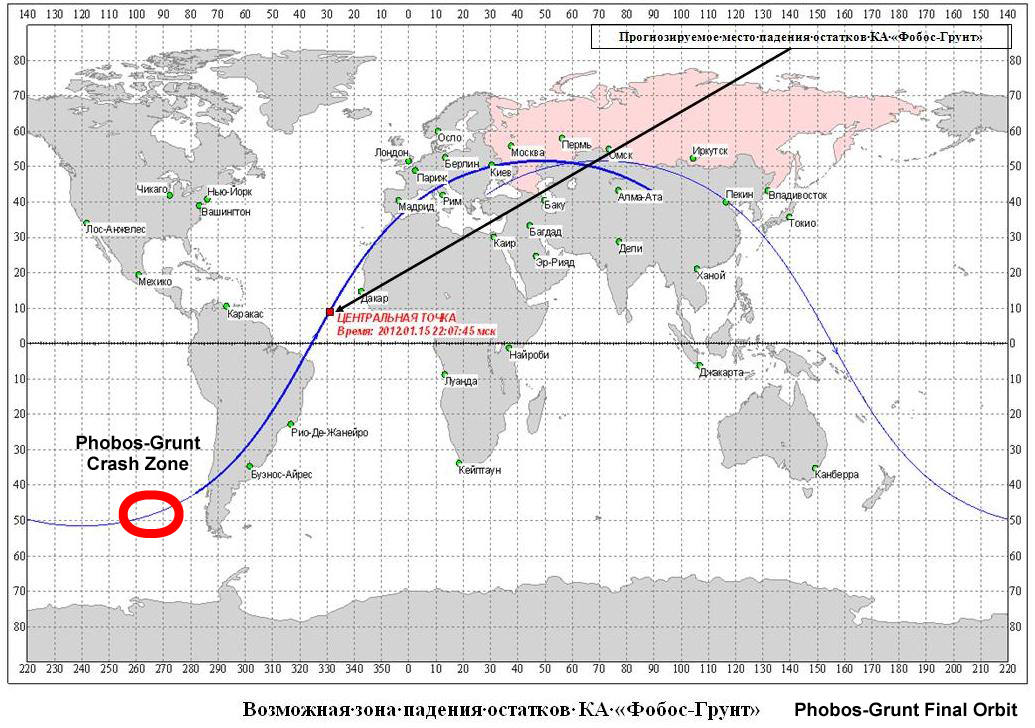
[/caption]
Story and Crash Zone Map updated 1 p.m. EST Jan 16
Today (Jan. 15) was the last day of life for Russia’s ambitious Phobos-Grunt mission to Mars after a desperate two month race against time and all out attempts to save the daring spaceship by firing up a malfunctioning thruster essential to putting the stranded probe on a trajectory to the Red Planet, failed.
According to the Russian news agency Ria Novosti, the doomed Phobos-Grunt spacecraft apparently plunged into the southern Pacific Ocean today, (Jan. 15) at about 12:45 p.m. EST, 21:45 Moscow time [17:45 GMT] after a fiery re-entry into the Earth’s atmosphere.
“Phobos-Grunt fragments have crashed down in the Pacific Ocean,” Russia’s Defense Ministry official Alexei Zolotukhin told RIA Novosti. He added that the fragments fell 1,250 kilometers to the west of the Chilean island of Wellington.
Universe Today will monitor the developing situation and update this story as warranted. On Jan. 16 Roscosmos confirmed the demise of Phobos-Grunt at 12:45 p.m. EST in the Pacific Ocean – during its last orbit; #1097.

The demise of the Phobos-Grunt spacecraft was expected sometime today, (Jan 15) after a fiery and destructive fall back to Earth, said Roscosmos, the Russian Federal Space Agency, in an official statement released early today before the crash.
Since the re-entry was uncontrolled, the exact time and location could not be precisely calculated beforehand.
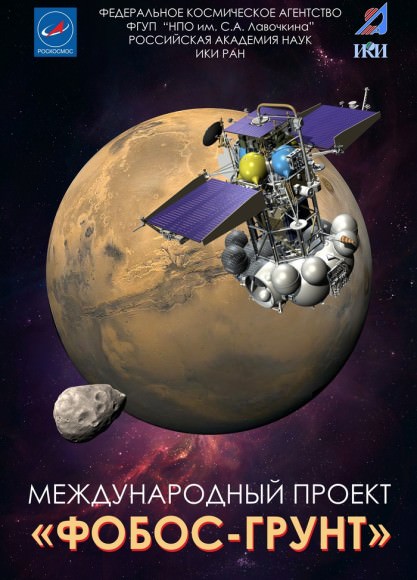
The actual crash time of the 13,500 kg space probe was slightly earlier than predicted.
Roscosmos head Vladimir Popovkin had previously stated that perhaps 20 to 30 fragments weighing perhaps 400 pounds (180 kg) might survive and would fall harmlessly to Earth.
The spacecraft burst into a large quantity of pieces as it hit the atmosphere, heated up and broke apart. But the actual outcome of any possible fragments is not known at this time.
Shortly after launching from the Baikonur Cosmodrome on Nov. 9, 2011, the probe became stuck in low Earth orbit after its MDU upper stage engines repeatedly failed to ignite and send the ship on a bold sample return mission to the tiny Martian Moon Phobos.
Phobos-Grunt was loaded with over 11,000 kg of toxic propellants, including dimethylhydrazine and dinitrogen tetroxide, that went unused due to the thruster malfunction and that were expected to be incinerated during the plunge to Earth.
Frictional drag forces from the Earth’s atmosphere had gradually lowered the ship’s orbit in the past two months to the point of no return after all attempts to fire the thrusters and raise the orbit utterly failed.
The audacious goal of Phobos-Grunt was to carry out history’s first ever landing on Phobos, retrieve 200 grams of soil and bring the treasured samples back to Earth for high powered analysis that could help unlock secrets to the formation of Mars, Phobos and the Solar System.
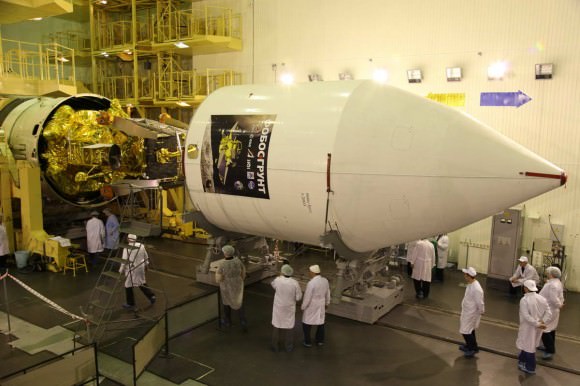
The Holy Grail of planetary science is to retrieve Martian soil samples – and scientists speculated that bits of the Red Planet could be intermixed with the soil of its mini moon Phobos, barely 15 miles in diameter.
The science return from Phobos-Grunt would have been first rate and outstanding.
It’s a sad end to Russia’s attempts to restart their long dormant interplanetary space science program.
The $165 mission was Russia’s first Mars launch in more than 15 years.

Credit: Fraunhofer FHR
Click to enlarge
Roscosmos had stated that the Atlantic Ocean – to the west of Africa – was at the center of the predicted crash zone. But nothing was certain and the probe had the possibility to crash sooner, perhaps over the Pacific Ocean or South America or later over Africa, Europe or Russia.
Roscosmos had predicted the time of the plunge to Earth to be from 12:50 p.m. EST and 1:34 p.m. EST (1750 to 1834 GMT) or 21:50 to 22: 34 Moscow time on January 15. The last orbit carried the probe over the Pacific Ocean towards South America on a northeasterly heading.
Russia enlisted assistance from ESA and the US in a bid to establish contact with the probe to reorient itself and fire up its engines for a belated journey to the Red Planet. Other than extremely brief signals the efforts proved futile and today’s Pacific plunge is the unfortunate end result.
Hopefully the Russians will not give up in despair, but rather fix the flaws and launch an exciting new Mars mission.
NASA has had better luck with their Mars mission this season.
The Curiosity Mars Science Lab rover is precisely on course to the Red Planet following the Jan 11 firing of the cruise stage thrusters for the first of up to 6 Trajectory Correction Maneuvers – read the details here
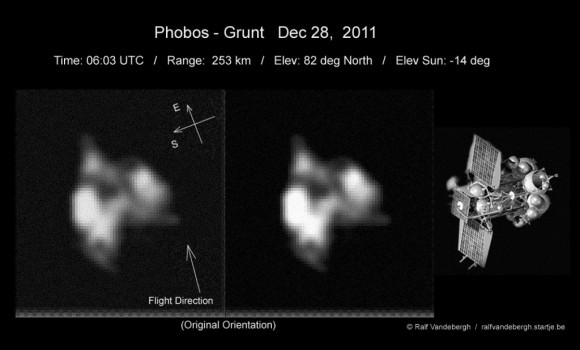
Read Complete Coverage about Phobos-Grunt, Curiosity and the Mars Rovers by Ken Kremer here:
Crucial Rocket Firing Puts Curiosity on Course for Martian Crater Touchdown
8 Years of Spirit on Mars – Pushing as Hard as We Can and Beyond !
2011: Top Stories from the Best Year Ever for NASA Planetary Science!
Opportunity Discovers Most Powerful Evidence Yet for Martian Liquid Water
Curiosity Starts First Science on Mars Sojurn – How Lethal is Space Radiation to Life’s Survival
Russians Race to Save Ambitious Phobos-Grunt Mars Probe from Earthly Demise
Russia’s Bold Sample Return Mission to Mars and Phobos Blasts Off
Russian Mars Moon Sample Probe Poised to Soar atop Upgraded Rocket – Video
Awesome Action Animation Depicts Russia’s Bold Robot Retriever to Mars moon Phobos
Phobos-Grunt and Yinghuo-1 Encapsulated for Voyage to Mars and Phobos
Phobos and Jupiter Conjunction in 3 D and Amazing Animation – Blastoff to Martian Moon near
Russia Fuels Phobos-Grunt and sets Mars Launch for November 9
Phobos-Grunt and Yinghou-1 Arrive at Baikonur Launch Site to tight Mars Deadline
Phobos-Grunt: The Mission Poster
Daring Russian Sample Return mission to Martian Moon Phobos aims for November Liftoff
Crucial Rocket Firing Puts Curiosity on Course for Martian Crater Touchdown
[/caption]
NASA’s car-sized Curiosity Mars Science Lab (MSL) rover is now on course to touch down inside a crater on Mars in August following the completion of the biggest and most crucial firing of her 8.5 month interplanetary journey from Earth to the Red Planet.
Engineers successfully commanded an array of thrusters on MSL’s solar powered cruise stage to carry out a 3 hour long series of more than 200 bursts last night (Jan. 11) that changed the spacecraft’s trajectory by about 25,000 miles (40,000 kilometers) – an absolute necessity that actually put the $2.5 Billion probe on a path to Mars to “Search for Signatures of Life !”
“We’ve completed a big step toward our encounter with Mars,” said Brian Portock of NASA’s Jet Propulsion Laboratory (JPL), Pasadena, Calif., deputy mission manager for the cruise phase of the mission. “The telemetry from the spacecraft and the Doppler data show that the maneuver was completed as planned.”

Credit: NASA TV
This was the first of six possible TCM’s or trajectory correction maneuvers that may be required to fine-tune the voyage to Mars.
Until now, Curiosity was actually on a path to intentionally miss Mars. Since the Nov. 26, 2011 blastoff from Florida, the spacecraft’s trajectory was tracking a course diverted slightly away from the planet in order to prevent the upper stage – trailing behind – from crashing into the Red Planet.
The upper stage was not decontaminated to prevent it from infecting Mars with Earthly microbes. So, it will now sail harmlessly past the planet as Curiosity dives into the Martian atmosphere on August 6, 2012.
The thruster maneuver also served a second purpose, which was to advance the time of the Mars encounter by about 14 hours. The TCM burn increased the velocity by about 12.3 MPH (5.5 meters per second) as the vehicle was spinning at 2 rpm.
“The timing of the encounter is important for arriving at Mars just when the planet’s rotation puts Gale Crater in the right place,” said JPL’s Tomas Martin-Mur, chief navigator for the mission.
Video caption: Rob Manning, Curiosity Mars Science Lab Chief Engineer at NASA JPL describes the Jan. 11, 2012 thruster firing that put the robot on a precise trajectory to Gale Crater on Mars. Credit: NASA/JPL
As of today, Jan. 12, the spacecraft has traveled 81 million miles (131 million kilometers) of its 352-million-mile (567-million-kilometer) flight to Mars. It is moving at about 10,300 mph (16,600 kilometers per hour) relative to Earth, and at about 68,700 mph (110,500 kilometers per hour) relative to the Sun.
The next trajectory correction maneuver is tentatively scheduled for March 26, 2012.
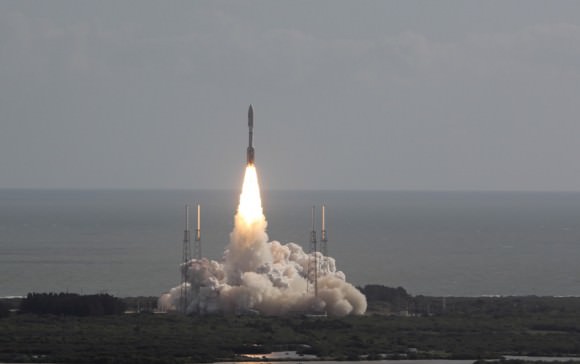
The goal of the 1 ton Curiosity rover is to investigate whether the layered terrain inside Gale Crater ever offered environmental conditions favorable for supporting Martian microbial life in the past or present and if it preserved clues about whether life ever existed.
Curiosity will search for the ingredients of life, most notably organic molecules – the carbon based molecules which are the building blocks of life as we know it. The robot is packed to the gills with 10 state of the art science instruments including a 7 foot long robotic arm, scoop, drill and laser rock zapper.

Schematic shows 8.5 month interplanetary trajectory of Curiosity. Credit: NASA/JPL-Caltech
Curiosity Countdown – 205 days to go until Curiosity lands at Gale Crater on Mars !
January 2012 marks the 8th anniversary of the landings of NASA’s Spirit and Opportunity Mars rovers back in January 2004.
Opportunity continues to operate to this day. Read my salute to Spirit here
Read continuing features about Curiosity and Mars rovers by Ken Kremer starting here:
8 Years of Spirit on Mars – Pushing as Hard as We Can and Beyond !
2011: Top Stories from the Best Year Ever for NASA Planetary Science!
Opportunity Discovers Most Powerful Evidence Yet for Martian Liquid Water
Flawlessly On Course Curiosity Cruising to Mars – No Burn Needed Now
NASA Planetary Science Trio Honored as ‘Best of What’s New’ in 2011- Curiosity/Dawn/MESSENGER
Curiosity Mars Rover Launch Gallery – Photos and Videos
Curiosity Majestically Blasts off on ‘Mars Trek’ to ascertain ‘Are We Alone?
Mars Trek – Curiosity Poised to Search for Signs of Life

